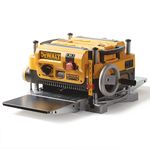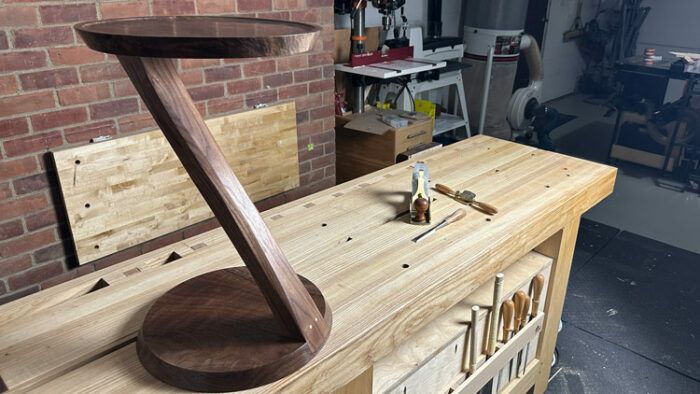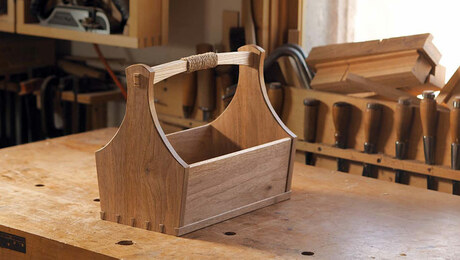Maybe the Best Time to Use That Special Piece of Lumber Is Now
An acquaintance of mine milled some walnut trees at his father’s home in Idaho and eventually got around to bringing a load back to the New York area. He was in the enviable position of having more lumber than he knew what to do with and sold me three of the slabs for a song. They were about 5 ft. long, 16 in. wide, and just over 2 in. thick. How much did he want? $40 a piece. He didn’t want more. He just wanted to share the bounty. As I drove off, he enthusiastically shouted, “Make something pretty!”
After years of woodworking, this was my first exposure to air-dried walnut. Having not been steamed, the wood had colors I wasn’t used to seeing in the lumber at my hardwood dealer—purples, blacks, grays, and, of course, a wide-range of rich browns. And being air-dried, it would be even more tool-friendly than its kiln-dried cousins. I was excited to put this wood to use and, indeed, make something pretty.
The slabs were already fully dry, as they had sat in a barn for several years after milling. There was no excuse not to put these to work right away. Well, there was one—that little nagging voice in the back of my head that insisted I only use them when I had found the perfect project for them, one that would optimize the usage of every cubic inch of this material.
Finding that “perfect project” proved to be more difficult than I originally suspected. I found myself wandering around the house, thinking of future builds (I share the goal of many fellow woodworkers: to eventually replace all the store-bought furniture in the house with furniture made in the shop), but nothing was springing to mind. A couple of pieces were on my to-do list, but the slabs were a few feet too short for a dining table and a few inches too narrow for a coffee table.
Not wanting to rush things, I put the three slabs aside for when that perfect project would come along.
Well, I certainly kept my word and didn’t rush things. Several years later they were still leaning against a wall in the back of my shop gathering dust, bumping against hips and elbows, and making the rear door of the garage unusable without a few minutes of juggling things around.
Finally, after an eternity (give or take), my wife requested a bench to place by the kitchen window. At last, an ideal use for one of the slabs! All the dimensions were spot on for what we envisioned to fill the space. I kept one live edge, heavily beveled another, and sculpted a third with hand tools. I turned the legs and stretchers from maple. And the material did indeed steal the show. The wood worked like a dream with both power and hand tools, and the depth and richness of the colors were something else.
I hope my lumber benefactor would agree that I did the lumber justice and made something “pretty”—or at least “pretty good.”
Not to sound melodramatic, but this wood genuinely put a smile on my face—both as I was building with it and in the finished project. I wasn’t about to let a few more years pass before I got to work with it again.
Side table from a walnut slab
When the next project came around, a relatively small side table, I jumped at the chance to use the second slab. Would there be waste? Yes. With the window bench I was able to use virtually the whole slab. With this table, I estimated about half of the walnut would end up in the dust collector or in my off-cut bin (which in a few years I’ll go through and wonder, “What the hell was I saving this tiny thing for?”).
I could have bought a couple of boards at my dealer to make this side table, but I loved the idea of the top and base being one piece of wood each—no glue-up required, and the beautifully figured walnut completely uninterrupted. Would it really be a waste of material if I couldn’t use every last bit? It’s amazing how much more enjoyment I’m getting in being able to use this table on a daily basis than I was when it was sitting in my garage as a rough slab, untouched because the the perfect project hadn’t come along. And when is anything perfect? Just ask my dovetails. The answer is “Rarely.”
With some luck, I’ll be around to do this craft for another 20 or 30 years. But when I’m gone, hopefully my kids and future grandkids will be deciding who gets which piece of furniture and not trying to figure out what they are going to do with all this “special” lumber—lumber that was never realized into something useful, functional, and pretty.
Fine Woodworking Recommended Products

DeWalt 735X Planer
At high speed, the planer works fast and leaves a smooth surface. But the slower, finish speed produces an almost glass-smooth surface. Knife changes are easy.

Ridgid R4331 Planer
Priced nearly $300 less than the DeWalt 735X, the Ridgid R4331 is an excellent value. Its three-knife cutterhead left wonderfully clean surfaces on plainsawn white oak and white pine. It did not perform nearly as well on curly maple as the 735X.

AnchorSeal Log and Lumber End-Grain Sealer
Good for both sealing the end grain of freshly cut logs and boards, this wax prevents end-grain checking and saves material
Sign up for eletters today and get the latest techniques and how-to from Fine Woodworking, plus special offers.





